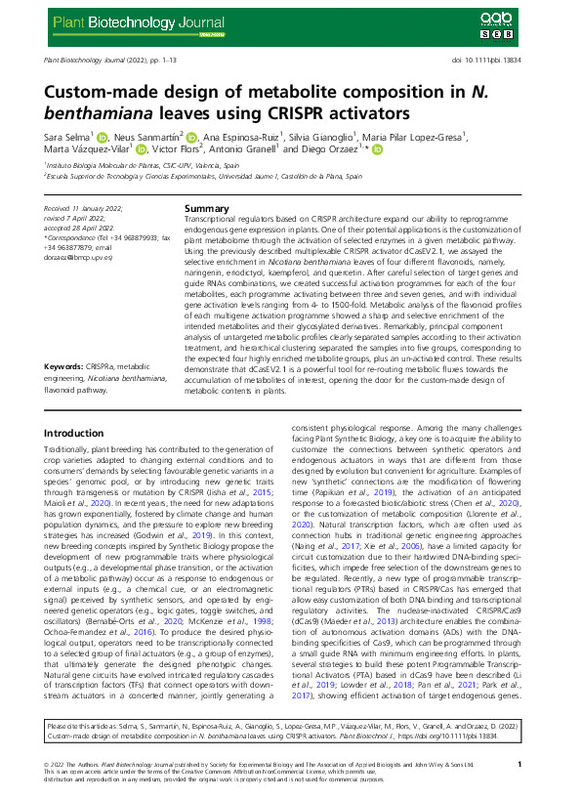JavaScript is disabled for your browser. Some features of this site may not work without it.
Buscar en RiuNet
Listar
Mi cuenta
Estadísticas
Ayuda RiuNet
Admin. UPV
Custom-made design of metabolite composition in N. benthamiana leaves using CRISPR activators
Mostrar el registro sencillo del ítem
Ficheros en el ítem
| dc.contributor.author | Selma, Sara
|
es_ES |
| dc.contributor.author | Sanmartín, Neus
|
es_ES |
| dc.contributor.author | Espinosa-Ruiz, Ana
|
es_ES |
| dc.contributor.author | Gianoglio, Silvia
|
es_ES |
| dc.contributor.author | López-Gresa, María Pilar
|
es_ES |
| dc.contributor.author | Vázquez-Vilar, Marta
|
es_ES |
| dc.contributor.author | Flors, Victor
|
es_ES |
| dc.contributor.author | GRANELL RICHART, ANTONIO
|
es_ES |
| dc.contributor.author | Orzáez Calatayud, Diego Vicente
|
es_ES |
| dc.date.accessioned | 2023-07-19T18:01:40Z | |
| dc.date.available | 2023-07-19T18:01:40Z | |
| dc.date.issued | 2022-08 | es_ES |
| dc.identifier.issn | 1467-7644 | es_ES |
| dc.identifier.uri | http://hdl.handle.net/10251/195217 | |
| dc.description.abstract | [EN] Transcriptional regulators based on CRISPR architecture expand our ability to reprogramme endogenous gene expression in plants. One of their potential applications is the customization of plant metabolome through the activation of selected enzymes in a given metabolic pathway. Using the previously described multiplexable CRISPR activator dCasEV2.1, we assayed the selective enrichment in Nicotiana benthamiana leaves of four different flavonoids, namely, naringenin, eriodictyol, kaempferol, and quercetin. After careful selection of target genes and guide RNAs combinations, we created successful activation programmes for each of the four metabolites, each programme activating between three and seven genes, and with individual gene activation levels ranging from 4- to 1500-fold. Metabolic analysis of the flavonoid profiles of each multigene activation programme showed a sharp and selective enrichment of the intended metabolites and their glycosylated derivatives. Remarkably, principal component analysis of untargeted metabolic profiles clearly separated samples according to their activation treatment, and hierarchical clustering separated the samples into five groups, corresponding to the expected four highly enriched metabolite groups, plus an un-activated control. These results demonstrate that dCasEV2.1 is a powerful tool for re-routing metabolic fluxes towards the accumulation of metabolites of interest, opening the door for the custom-made design of metabolic contents in plants. | es_ES |
| dc.description.sponsorship | This work has been funded by Grant PID2019-108203RB-10 Plan Nacional I+D, Spanish Ministry of Science and Innovation and Spanish Ministry of Economy and Competitiveness. Sara Selma is a recipient of FPI fellowship associated with this Grant (BIO2016-78601-R). | es_ES |
| dc.language | Inglés | es_ES |
| dc.publisher | Blackwell Publishing | es_ES |
| dc.relation.ispartof | Plant Biotechnology Journal | es_ES |
| dc.rights | Reconocimiento - No comercial (by-nc) | es_ES |
| dc.subject | CRISPRa | es_ES |
| dc.subject | Metabolic engineering | es_ES |
| dc.subject | Nicotiana benthamiana | es_ES |
| dc.subject | Flavonoid pathway | es_ES |
| dc.subject.classification | BIOQUIMICA Y BIOLOGIA MOLECULAR | es_ES |
| dc.title | Custom-made design of metabolite composition in N. benthamiana leaves using CRISPR activators | es_ES |
| dc.type | Artículo | es_ES |
| dc.identifier.doi | 10.1111/pbi.13834 | es_ES |
| dc.relation.projectID | info:eu-repo/grantAgreement/MINECO//BIO2016-78601-R/ | es_ES |
| dc.relation.projectID | info:eu-repo/grantAgreement/AEI/Plan Estatal de Investigación Científica y Técnica y de Innovación 2017-2020/PID2019-108203RB-I00/ES/EXPLOITING THE MODULAR ARCHITECTURE OF CRISPR%2FCAS TO DESIGN PROGRAMMABLE GENE CIRCUITS AND OTHER NEW BREEDING TOOLS IN PLANTS/ | es_ES |
| dc.rights.accessRights | Abierto | es_ES |
| dc.contributor.affiliation | Universitat Politècnica de València. Escuela Técnica Superior de Ingeniería Agronómica y del Medio Natural - Escola Tècnica Superior d'Enginyeria Agronòmica i del Medi Natural | es_ES |
| dc.description.bibliographicCitation | Selma, S.; Sanmartín, N.; Espinosa-Ruiz, A.; Gianoglio, S.; López-Gresa, MP.; Vázquez-Vilar, M.; Flors, V.... (2022). Custom-made design of metabolite composition in N. benthamiana leaves using CRISPR activators. Plant Biotechnology Journal. 20(8):1578-1590. https://doi.org/10.1111/pbi.13834 | es_ES |
| dc.description.accrualMethod | S | es_ES |
| dc.relation.publisherversion | https://doi.org/10.1111/pbi.13834 | es_ES |
| dc.description.upvformatpinicio | 1578 | es_ES |
| dc.description.upvformatpfin | 1590 | es_ES |
| dc.type.version | info:eu-repo/semantics/publishedVersion | es_ES |
| dc.description.volume | 20 | es_ES |
| dc.description.issue | 8 | es_ES |
| dc.identifier.pmid | 35514036 | es_ES |
| dc.identifier.pmcid | PMC9342607 | es_ES |
| dc.relation.pasarela | S\468705 | es_ES |
| dc.contributor.funder | Agencia Estatal de Investigación | es_ES |
| dc.contributor.funder | Ministerio de Economía y Competitividad | es_ES |








